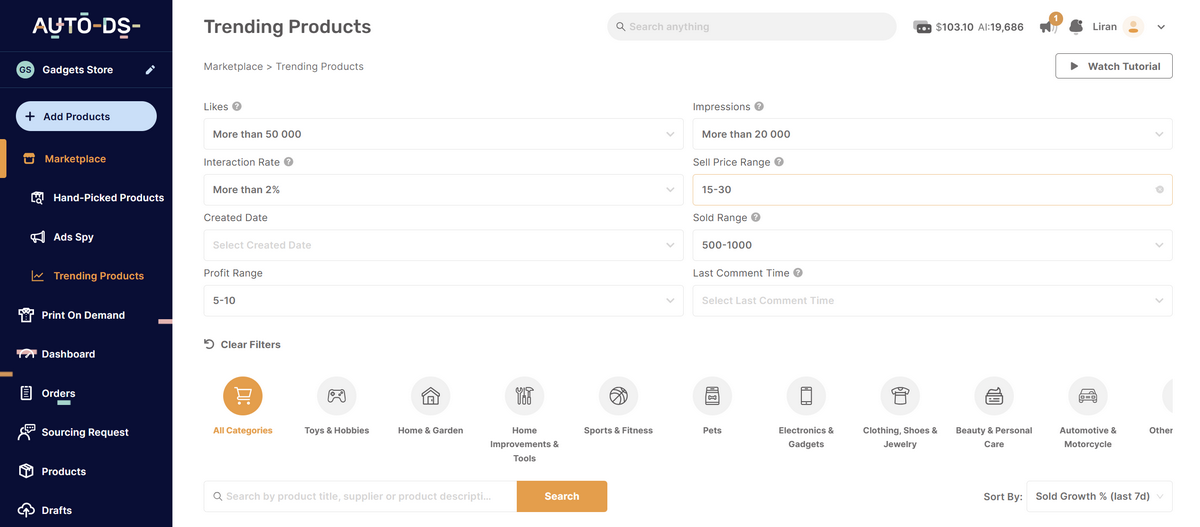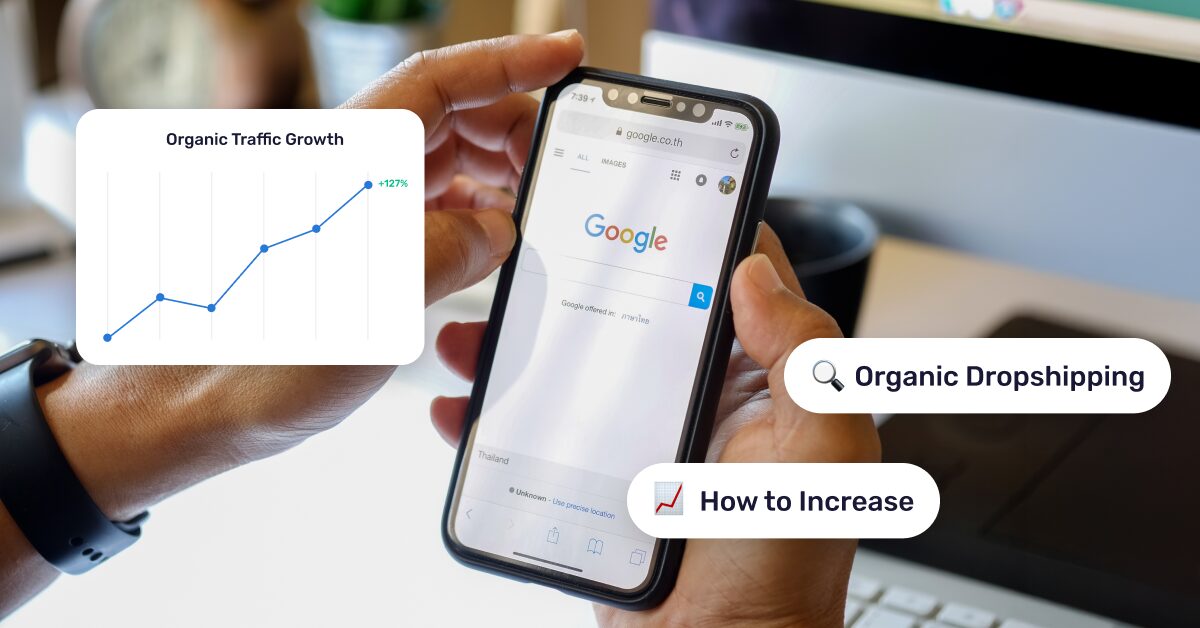Organic Dropshipping: A Smarter Way to Build a Store
Running a dropshipping store in 2025 can feel like a constant balancing act. On one side, you’ve got paid ads—fast, but expensive and unpredictable. On the other side, there’s a quieter, slower, but more reliable approach: organic dropshipping. Instead of spending money on Meta or Google ads every day, you attract customers through free or low-cost channels like SEO, social media, content, and influencer collaborations.
The beauty of organic growth is that it’s perfect for building something sustainable. Customers trust brands they discover rather than brands that chase them with ads. Over time, that trust translates into consistent traffic and steady sales.
Of course, organic dropshipping requires patience. You won’t wake up to hundreds of orders overnight, but once your store gains momentum, the growth snowballs. And here’s the best part: while you focus on crafting blogs, TikToks, or SEO strategies, AutoDS provides automation for product imports, optimized descriptions, and fulfillment, saving dropshippers hours each week and letting them put energy where it counts: organic growth.
Organic dropshipping means building traffic without ads, using SEO, social, and content.
At first, organic dropshipping can be slower, but it creates sustainable, compounding growth over time
SEO is the core: unique product pages, keyword research, and site speed drive results.
Social media (TikTok, Instagram, Pinterest) + blogs + influencer seeding = top organic channels.
AutoDS automates fulfillment, imports, and product updates, giving dropshippers more time to focus on organic growth.
What is Organic Dropshipping And Why It Works

Organic dropshipping is all about earning visibility instead of paying for it. When a shopper finds your store naturally—through a Google search, a TikTok video, a Pinterest board, or even a blog post—you immediately gain a layer of credibility.
Think about it: if you’re searching for “best sustainable yoga mat” and you land on a helpful guide that explains the pros and cons of different mats before recommending one, you’re more likely to trust that brand compared to a random ad screaming “Buy Now!” in your feed.
This matters because today’s customers are skeptical. Paid ads are everywhere, and people know they’re being targeted. But organic discovery feels different—it feels like they found you. That shift in perception builds loyalty, not just one-off impulse buys.
The approach works for three main reasons:
- Less dependency on ads: Instead of stressing over rising CPCs or sudden Facebook bans, you’re building a marketing engine you actually control. Google searches, blog posts, and social followers don’t disappear just because an algorithm changes overnight.
- Better ROI long term: Content costs time and effort upfront, but keeps paying dividends. HubSpot research shows that businesses that publish blogs consistently generate 67% more leads per month than those that don’t. Unlike ads, a well-optimized blog or video keeps bringing in traffic with no additional spend.
- Passive potential: Once you have content ranking on Google or TikTok videos consistently getting views, sales can come in 24/7—even when you’re not actively promoting. It’s like planting seeds that keep growing without needing to replant every week.
Of course, “passive” doesn’t mean “effortless.” Organic dropshipping requires strategy, patience, and consistency. But the trade-off is worth it: you’re building a foundation that pays over time, while others keep paying for every click.
Pros & Cons of Organic Dropshipping
Organic dropshipping sounds amazing when you first hear about it—no ads, no big marketing spend, just free traffic flowing into your store. And while that’s true, the full picture has both advantages and trade-offs. To really understand if this path fits your business goals, let’s look at the real pros and cons of this dropshipping model.
✅ Pros of Organic Dropshipping
- Low Cost (especially upfront). You’re not pouring hundreds—or thousands—into Meta, TikTok, or Google ads every month. Instead, your main investment is time and effort. For beginners with a limited budget, this is huge. You can grow a store without draining your bank account just to “test” products.
- Sustainable Growth. Every blog, TikTok, or pin you post becomes a digital asset that keeps working for you long after it’s published. Unlike ads that disappear when the budget dries up, organic content keeps attracting people over weeks, months, and sometimes years. It’s a snowball effect: slow at first, but once it picks up speed, momentum builds naturally.
- Builds Brand Authority. If someone finds you through a helpful blog article or an informative YouTube video, they’ll see your brand as trustworthy. That’s not just a sale—it’s the beginning of customer loyalty. Over time, you’re not just “a dropshipping store” but the go-to brand in your niche.
- Freedom From Ad Platforms. Anyone who’s ever had a Facebook Ads account disabled overnight knows the pain. Organic traffic shields you from that stress. You’re not dependent on one platform’s rules or auction prices.
❌ Cons of Organic Dropshipping
- Slower Results. This is the biggest downside. With ads, you can test a product and see sales tomorrow. With organic dropshipping, expect weeks or even months before you see meaningful traction. SEO in particular is a long game—Google rewards consistency and quality, not quick hacks.
- Requires Consistency and Patience. Publishing one blog post or TikTok and waiting for magic won’t cut it. You need a steady flow of content, regular optimization, and active engagement. That means showing up even when results are slow. For many new sellers, this discipline is the hardest part.
- Harder to Scale at First. Ads are like gasoline—you can pour money in and instantly reach more people. Organic growth is more like planting trees. You’ll eventually have a whole forest, but it takes longer. In the early stages, scaling feels limited compared to ad-driven models.
- Competitive Niches Are Tougher. Trying to rank for “best sneakers” or “wireless headphones” organically? Almost impossible unless you’re a giant. Niche-specific keywords and micro-communities are where new dropshippers have the best chance to shine.
🆕 Beginner’s Tip: Start small with one or two organic channels (like blogging and TikTok). Spreading yourself too thin across every platform at once is a recipe for burnout.
Key Organic Marketing Channels for Dropshipping

Organic growth isn’t a one-size-fits-all strategy—it’s a toolkit. The magic happens when you combine the right channels and adapt them to your niche. Let’s break down the most powerful organic marketing channels you can use to grow a dropshipping store in 2025.
SEO for Dropshipping Stores
Search Engine Optimization (SEO) is the cornerstone of organic growth. Why? Because people searching for products on Google already have buying intent. Ranking for the right keywords can mean free, consistent traffic for years.
How to apply SEO to your store:
- Unique product descriptions: Never copy-paste from suppliers. Google penalizes duplicate content, and your listings won’t rank. Instead, add unique descriptions that include keywords naturally.
- Long-tail keywords: Instead of competing for “yoga mat” (impossible for a new store), target “eco-friendly yoga mat Italy” or “non-slip yoga mat for hot yoga.” Long-tail keywords are less competitive and bring in highly motivated buyers.
- Content-rich blog: Answer customer questions in blog posts like “Are bamboo kitchen utensils dishwasher safe?” These posts rank for informational queries and funnel traffic to your product pages.
- Backlinks: Collaborate with niche bloggers or even suppliers to get backlinks. These links act as votes of credibility, pushing your site higher in Google rankings.
📢 Marketing Tip: If your supplier provides high-quality product images or spec sheets, repurpose that material in SEO-friendly blogs or infographics. Google loves multimedia-rich pages.
Social Media Marketing (Without Ads)
Paid social media is expensive, but organic social still works, especially in 2025 when algorithms reward authentic, engaging content. Social platforms are where people discover products they didn’t know they wanted.
Best platforms for organic dropshipping growth:
- TikTok Organic: This is where products go viral. Use trending sounds, challenges, or quick demo videos. A single 15-second TikTok of a clever kitchen gadget can bring thousands of views overnight. You can even dropship organically on TikTok!
- Instagram Reels & Stories: Perfect for behind-the-scenes content, customer reviews, and “day in the life” style videos that humanize your brand. Stories also create direct interaction with polls, Q&As, and stickers.
- Pinterest: Still underrated. It’s basically a visual search engine where posts can keep driving clicks years after publishing. Great for the best dropshipping niches, like home décor, fashion, and lifestyle products.
📢 Marketing Tip: Batch content creation. Record five TikToks in one sitting and drip them out across the week. This keeps your account active without daily stress.
Content Marketing
Content marketing turns your store into more than just a place to buy—it makes it a resource. Think of your content as a magnet: it attracts, educates, and nudges people toward a purchase.
Ways to leverage content marketing:
- Blogging: Product reviews (“Best Vegan Backpacks for 2025”), buying guides, and comparison posts. These posts attract search traffic and guide readers to your products.
- YouTube: Tutorials, unboxings, and “how-to” videos perform well. Example: “How to style vegan leather bags with everyday outfits.”
- Email Marketing: Start building your list from day one. Even if you get only 10 sign-ups a week, in six months you’ll have 250+ people you can reach directly with offers, updates, and product drops.
🔍 Research Tip: Use free tools like Google Trends or AnswerThePublic to see what people in your niche are searching for. Then create blogs or videos that answer those queries.
Influencer Collaborations (Product Seeding)
Influencer marketing doesn’t always mean big budgets. Product seeding—sending products for free in exchange for content—is one of the most effective ways to grow organically in 2025.
How to do it:
- Focus on micro-influencers (1k–10k followers). They have smaller but highly engaged audiences. Their reviews often feel more authentic than big-name influencers.
- Start with a DM pitch: offer them the product for free, no strings attached. Many will naturally post about it if they like it.
- Repurpose their content on your own channels (with permission). This adds instant social proof.
Dropshipping SEO: The Core of Organic Growth
If organic dropshipping were a house, SEO would be the foundation. You can post TikToks, send emails, or partner with influencers, but if your store isn’t optimized for search engines, you’re missing the biggest driver of free, consistent traffic. In fact, 53% of all website traffic comes from organic search (BrightEdge, 2024), which shows just how crucial SEO is for long-term e-commerce growth.
The good news? You don’t need to be an SEO wizard to make your dropshipping store visible. What you do need is a clear system and showing up regularly.
Do Strategic Keyword Research

Every SEO strategy starts with understanding what your customers are typing into Google. For dropshipping, you want a mix of product keywords and informational keywords.
- Product keywords: These are your money-makers. Example: “vegan leather tote bag” or “wireless charging desk lamp.”
- Informational keywords: These pull in traffic earlier in the buying journey. Example: “how to clean vegan leather” or “best lighting for home offices.”
📦 Supplier’s Tip: Use your supplier’s catalog for inspiration. Look at the keywords they use, then expand with tools like Google Keyword Planner or Ubersuggest to find low-competition variations.
Optimize Product Pages Like Mini Landing Pages
Many dropshippers just copy supplier descriptions—a bad move. Instead, treat each product page as a mini landing page built to rank.
- Add a unique description with your target keyword in the title, meta description, and headers.
- Write at least 300–500 words per product page (yes, Google loves text, even on product listings).
- Include high-quality images and even a short demo video if possible.
- Add customer FAQs to the page. Google loves Q&A formats because they match search intent.
Focus on Site Speed & Mobile Optimization

Dropshipping statistics project that 62% of global e-commerce sales will come from mobile in 2025. If your store takes longer than 3 seconds to load on a phone, you’re losing sales and rankings.
- Compress images without losing quality (use free tools like TinyPNG).
- Use a lightweight Shopify theme optimized for speed.
- Test your store on Google’s free PageSpeed Insights tool.
Build a Strong Internal Linking Structure
Think of internal linking as building roads inside your store. Without them, visitors (and Google crawlers) get lost.
- Link blog posts → product pages (example: a blog on “Top 5 Eco-Friendly Travel Essentials” linking to your eco-friendly backpack listing).
- Link product pages → category pages to strengthen your site’s architecture.
- Add “related products” suggestions at the bottom of every listing.
Don’t Forget Category Pages
Don’t sleep on category pages. Optimizing them can get you just as much organic love as your product listings. For example, instead of only optimizing a single “eco yoga mat” page, optimize the entire “eco-friendly yoga gear” category.
Patience Is Part of the Strategy
SEO isn’t instant gratification. According to Ahrefs, the average top 10 ranking page is over 2 years old. That doesn’t mean you need to wait two years—it means results compound with time. You might start seeing clicks in 6–12 weeks, but serious traffic usually shows up between 3–6 months of consistent effort.
Imagine your blog ranks for “best vegan leather bags 2025” and drives 1,500 visits per month. If even 2% convert at $40 profit per sale, that’s $1,200 in monthly profit—without a dollar spent on ads. That’s the power of dropshipping SEO.
How Can AutoDS Help With Organic Dropshipping

Here’s the truth: organic dropshipping takes time. Writing blog posts, filming TikToks, and optimizing product pages all demand focus. If you also spend hours importing products, updating prices, or manually fulfilling orders, you’ll burn out before the traffic even starts rolling in. That’s where automation becomes your secret weapon.
AutoDS gives dropshippers the freedom to focus on growth while the repetitive backend work runs on autopilot. Even if you’re not spending a cent on ads, scaling still matters—and automation makes it possible.
1. One-Click Product Importer
You find a trending product you want to blog about or feature in a TikTok? With AutoDS, it’s in your store in seconds—complete with images, variants, and descriptions.
2. AI-Powered Store Builder
Starting from scratch? The AI Shopify Store Builder can create a fully functioning store in minutes—preloaded with products, optimized descriptions, and a professional design. That means you can launch faster and start testing organic strategies without wasting weeks setting up pages.
3. Automated Price & Stock Monitoring
Organic growth relies on credibility. Nothing kills credibility like a customer clicking “buy” only to find out the product is sold out or mispriced. AutoDS continuously syncs inventory and prices with your suppliers, so your store always reflects real availability.
👉 Ready to focus on growing instead of juggling backend chaos? Start your AutoDS trial for just $1 today and scale your organic-first store without limits.
4. Fulfilled by AutoDS
When orders start coming in, AutoDS’ fulfillment service processes them automatically—even handling tracking updates. With AutoDS, you don’t have to manually input each order; it’s all handled while you keep producing content.
5. Product Research That Fuels Content
Organic dropshipping thrives on knowing what people are searching for. AutoDS’ product research tools let you spot trending, high-demand items before they saturate.
💰 Financial Tip: Treat organic content like an investment. If each blog post costs you a few hours (or a few dollars to outsource) but brings in sales for months, the ROI compounds.
Frequently Asked Questions
What is organic dropshipping?
Organic dropshipping is running a store without ads—using SEO, blogs, social, email, and community to bring in traffic. It’s a long-term, trust-based approach. And while you grow organically, AutoDS automates fulfillment, imports, and updates so your store keeps running efficiently.
How long does dropshipping SEO take to work?
Expect 6–12 weeks for early keyword traction, and 3–6 months for consistent traffic. Results depend on niche competition and publishing consistency. With AutoDS managing product updates, your SEO foundation stays strong while you wait for rankings.
Do I need a blog, or can I rank with just product pages?
Product pages can rank, but blogs multiply keyword opportunities and funnel readers into products. Guides, comparisons, and FAQs are essential for building topical authority.
What are the best organic channels for a new store (no ads)?
Start with SEO and a blog as your foundation. Then layer in TikTok/Instagram for discovery, Pinterest for evergreen searches, and email to retain traffic. Product seeding with micro-influencers adds social proof early on.
Start Organic Dropshipping Today!
Organic dropshipping isn’t the fastest way to build a store—but it is one of the smartest. Instead of chasing every new ad trend or worrying about rising CPC costs, you’re building a business that runs on trust, authority, and long-term visibility. Yes, it takes commitment. Yes, it takes consistency. But the payoff is a brand that grows steadily and doesn’t collapse the moment an ad account gets banned.
The smartest move? Start with SEO as your foundation, then layer on social media, content, and influencer seeding. Each piece of content you create becomes an asset that works for you day and night. While you focus on planting those seeds, AutoDS makes sure the roots are strong—handling fulfillment, imports, price updates, and everything else that could slow you down.
So if you’re serious about building a dropshipping business that doesn’t just survive but thrives in 2025, organic is the way forward.
👉 Start optimizing your store for organic growth today—your future sales will thank you.
Keep Reading: Recommended Articles for You
















